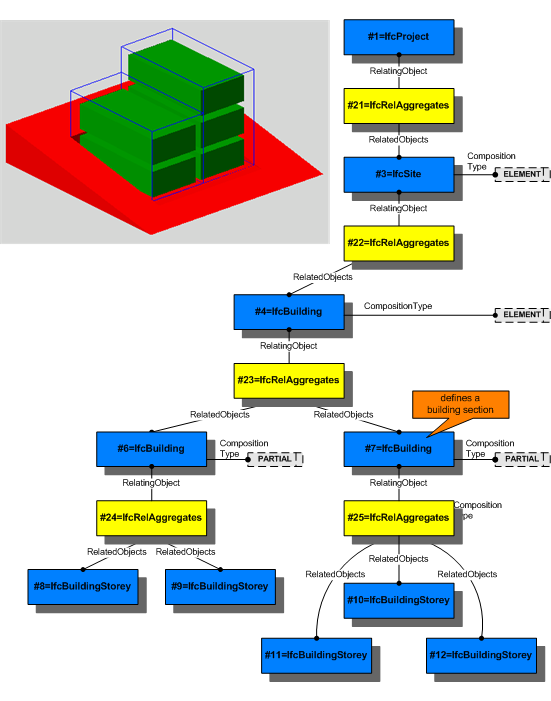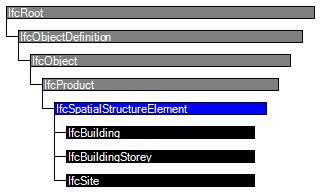Semantic definitions at the entity
Entity definition
A spatial structure element (IfcSpatialStructureElement) is the generalization of all spatial elements that might be used to define a spatial structure. That spatial structure is often used to provide a project structure to organize a building project.
A spatial project structure might define as many levels of decomposition as necessary for the building project. Elements within the spatial project structure are:
- site as IfcSite
- building as IfcBuilding
- storey as IfcBuildingStorey
- space as IfcSpace
or aggregations or parts thereof. The composition type declares an element to be either an element itself, or an aggregation (complex) or a decomposition (part). The interpretation of these types is given at each subtype of IfcSpatialStructureElement.
The IfcRelAggregates is defined as an 1-to-many relationship and used to establish the relationship between exactly two levels within the spatial project structure. Finally the highest level of the spatial structure is assigned to IfcProject using the IfcRelAggregates.
Informal proposition:
- The spatial project structure, established by the IfcRelAggregates, shall be acyclic.
- A site should not be (directly or indirectly) associated to a building, storey or space.
- A building should not be (directly or indirectly) associated to a storey or space.
- A storey should not be (directly or indirectly) associated to a space.
HISTORY New entity in IFC Release 2x.
Spatial Structure Use Definition

|
The figure shows the use of IfcRelAggregates to establish a spatial structure including site, building, building section and storey. More information is provided at the level of the subtypes. |
Attribute definitions
| # | Attribute | Type | Cardinality | Description | A |
|---|---|---|---|---|---|
| 8 | LongName | - | This attribute is out of scope for this model view definition and shall not be set. | ||
| 9 | CompositionType | IfcElementCompositionEnum | [1:1] | Denotes, whether the predefined spatial structure element represents itself, or an aggregate (complex) or a part (part). The interpretation is given separately for each subtype of spatial structure element. | X |
| ContainsElements | IfcRelContainedInSpatialStructure @RelatingStructure | S[0:?] |
Set of spatial containment relationships, that holds those elements, which are contained within this element of the project spatial structure.
NOTE The spatial containment relationship, established by IfcRelContainedInSpatialStructure, is required to be an hierarchical relationship, i.e. each element can only be assigned to 0 or 1 spatial structure element. | X |
Formal Propositions
| Rule | Description |
|---|---|
| WR41 | All spatial structure elements shall be associated (using the IfcRelAggregates relationship) with another spatial structure element, or with IfcProject. |

 EXPRESS-G diagram
EXPRESS-G diagram Link to this page
Link to this page